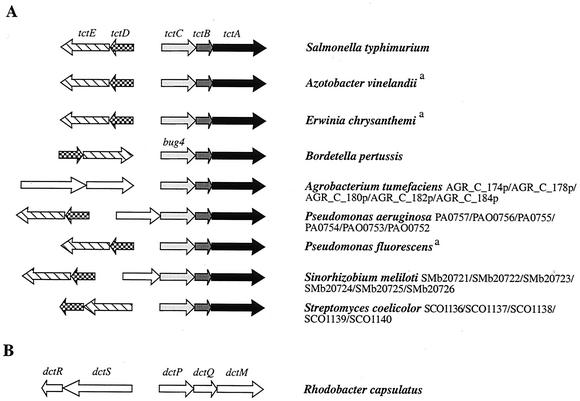FIG. 1.
Organization of selected operons encoding predicted TTTs and comparison with the dctPQM operon that encodes the archetype of TRAP transporters. (A) tct operon of S. enterica serovar Typhimurium is shown as the paradigm for TTT systems. Homologs of tctC, tctB, and tctA are shown in light gray, dark gray, and black, respectively. Homologs of tctE and tctD, coding for the sensor kinase and response regulator of a two-component system involved in the regulation of tctCBA (29), are depicted as hatched and checkered arrows, respectively. Among the three predicted TTT-coding operons of Agrobacterium tumefaciens, only the one depicted here is preceded by an operon encoding a two-component system. It is not homologous to TctDE but to DctRS of Rhodobacter capsulatus, involved in the regulation of the dicarboxylate transporter operon dctPQM (see panel B). Additional genes (in white) are found in a few operons; these include genes presumably coding for a porin in Pseudomonas aeruginosa and for an ESR associated with ABC uptake transporters in Sinorhizobium meliloti. a, no accession numbers are yet available for Azotobacter vinelandii, Erwinia chrysanthemi, and Pseudomonas fluorescens. (B) The dctPQM operon that encodes the dicarboxylate TRAP transporter of Rhodobacter capsulatus (10) and the adjacent dctRS operon that encodes a two-component system are shown for comparison purposes. Although not homologous, TTT and TRAP transporters have similar molecular organizations.

